Want to make an all-natural laundry detergent as effective as commercial detergent? Your search is over. Here’s how to make the best DIY homemade laundry detergent. And all you need is 3 key ingredients and 15 minutes.
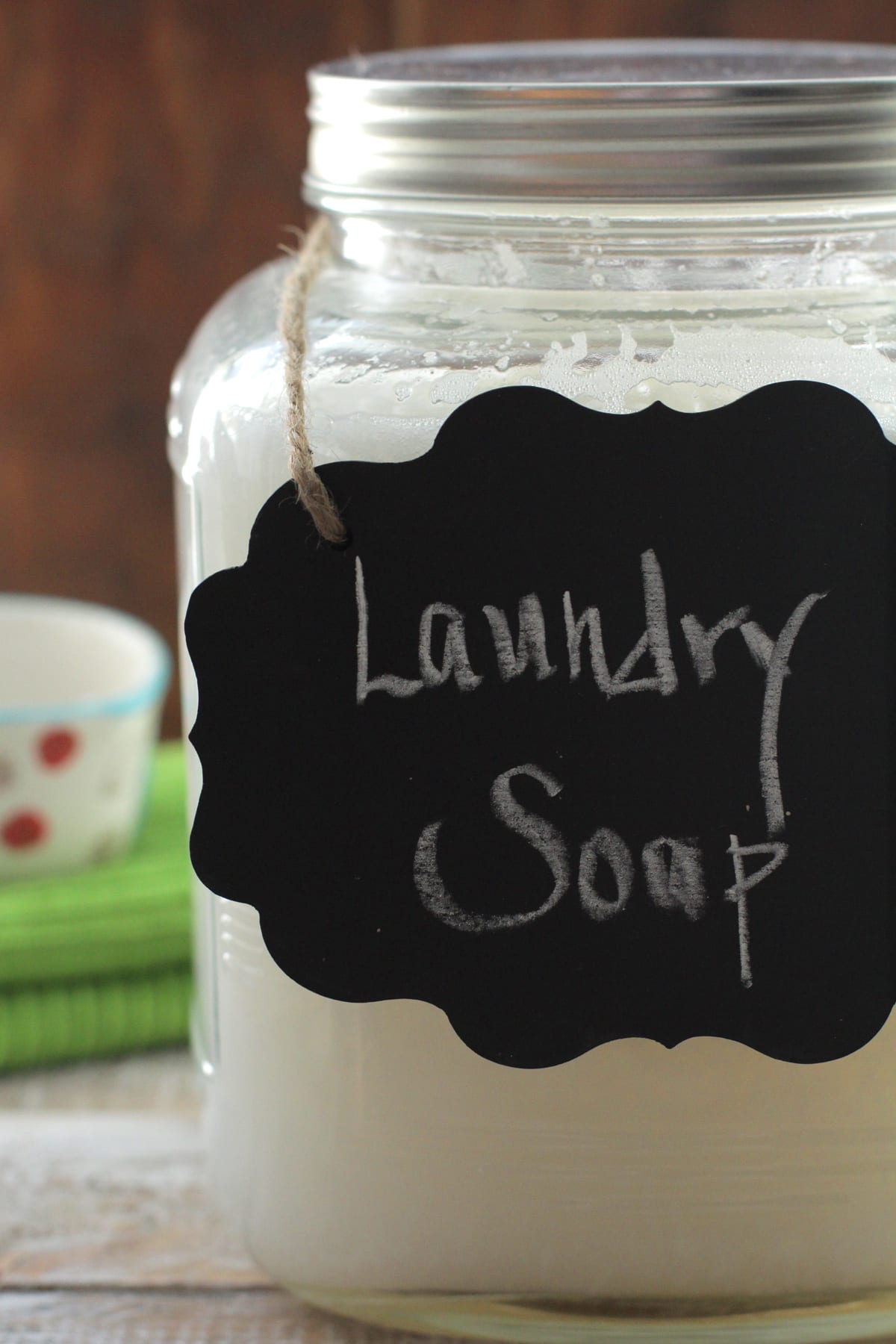
Want to Save This Article?
Enter your email & I’ll send it straight to your inbox. And you’ll get new recipes & tips each week.
11 years ago, I started making the switch to natural cleaning products, including laundry detergent!
At that time, the majority of recipes online called for a bar of fels naptha, washing soda, and Borax. But there was one problem: our clothes came out with chalky white spots.
So I made a simple swap: liquid Dr. Bronner’s castile soap instead of the fels naptha soap bar. With this one change, the detergent worked just as good as Tide.
This recipe is non-toxic, fights stains better than commercial detergent, and is cheap! I’ve been making this liquid laundry detergent for over 11 years (originally created in 2014) because of its extraordinary cleaning power.
Homemade Laundry Detergent Benefits
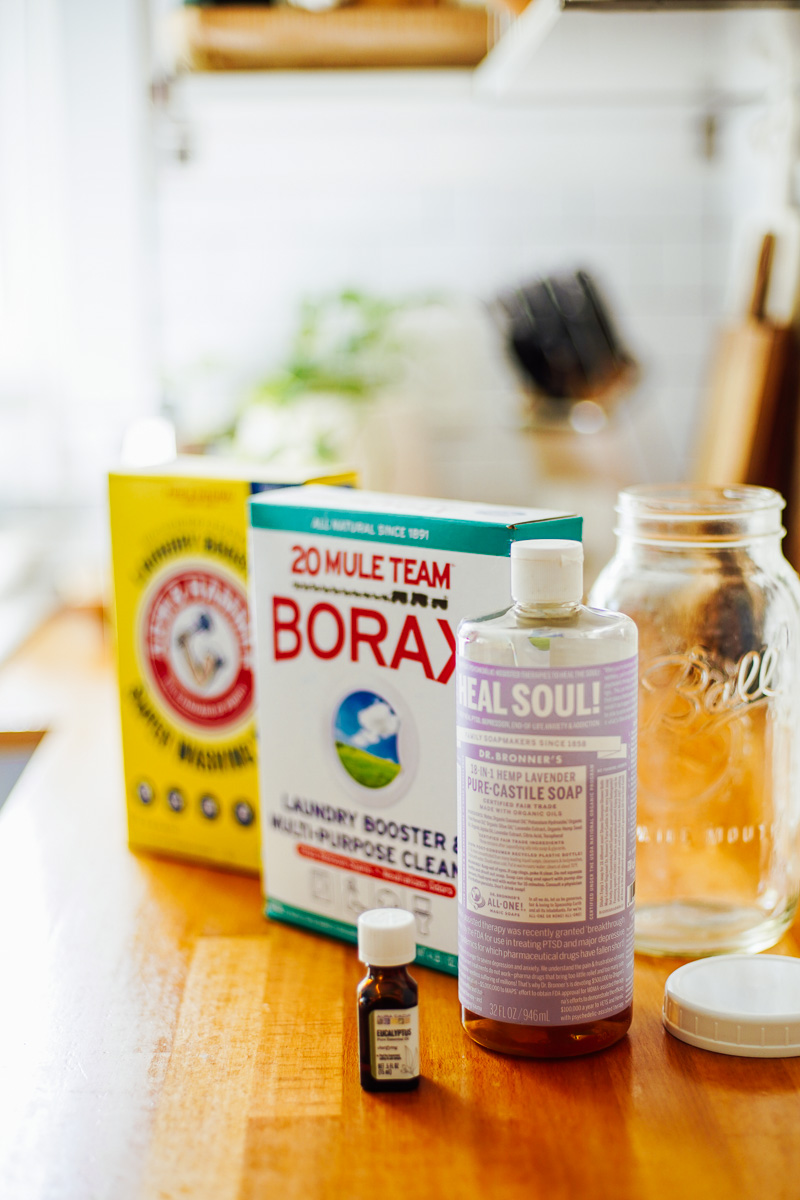
Before You Get Started: What You’ll Need
Ingredients
This recipe, made with simple ingredients, makes 1 gallon of homemade soap.
- 1 cup borax – freshens, deodorizes, and lifts dirt and stains
- 1 cup washing soda – freshens and deodorizes
- 1 cup liquid castile soap or Sal Suds – the main cleaning agent, lifts dirt and cleans
- 50 drops essential oil – optional for a scent
- 15 cups water – distilled water, found in any grocery store, is best as it doesn’t contain containments found in tap or filtered water
Equipment
- Large saucepan or Dutch oven – enough to hold 1 gallon of liquid, 15 cups
- Storage Jars – such as 2 half gallon-size glass mason jars, 1 gallon-size jar, or reuse an old detergent bottle
Thicker Detergent Tip: This recipe calls for 15 cups of water. If you’d like a thicker, more concentrated soap, use 10-12 cups of water.
How to Make Homemade Laundry Detergent: Recipe Steps
- Step 1 Boil 6 Cups of Water: In a large saucepan or Dutch oven, bring 6 cups of water to a slight boil. Once the water begins to boil, turn off the burner.
- Step 2 Add Borax, Washing Soda, More Water, and Castile Soap: Add the Borax and washing soda. Stir to dissolve. Then add 9 cups of room-temperature water and 1 cup of liquid castile soap. Give the ingredients a stir to combine.
- Step 3 Cool for 5-10 Minutes: Allow the soap to cool for a few minutes before pouring into one large gallon-size jar or smaller containers, like quart-size jars. Make sure your jar(s) are heat-safe. If not, wait until the soap is cool, then spoon the soap into the jar(s).
- Step 4 Add Essential Oil For Scent: Add an essential oil of choice (if using) to the soap (now in the jar) and stir to combine with the detergent.
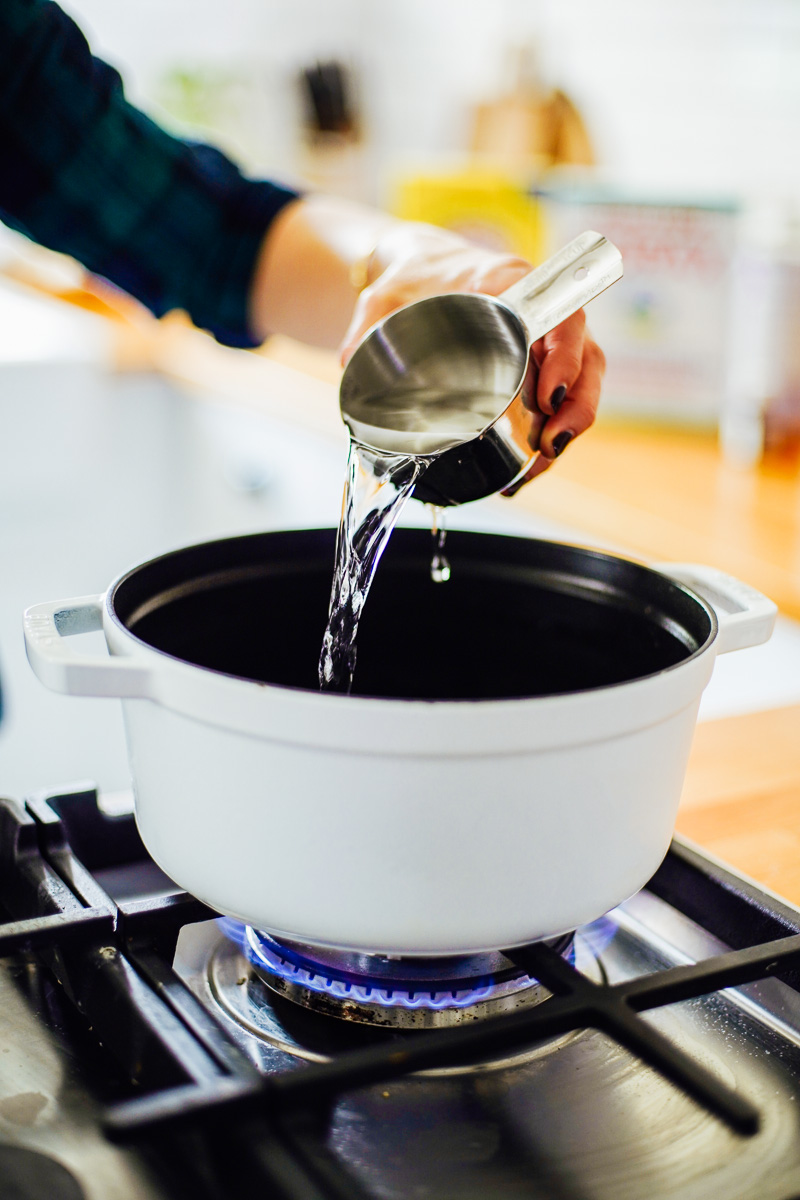
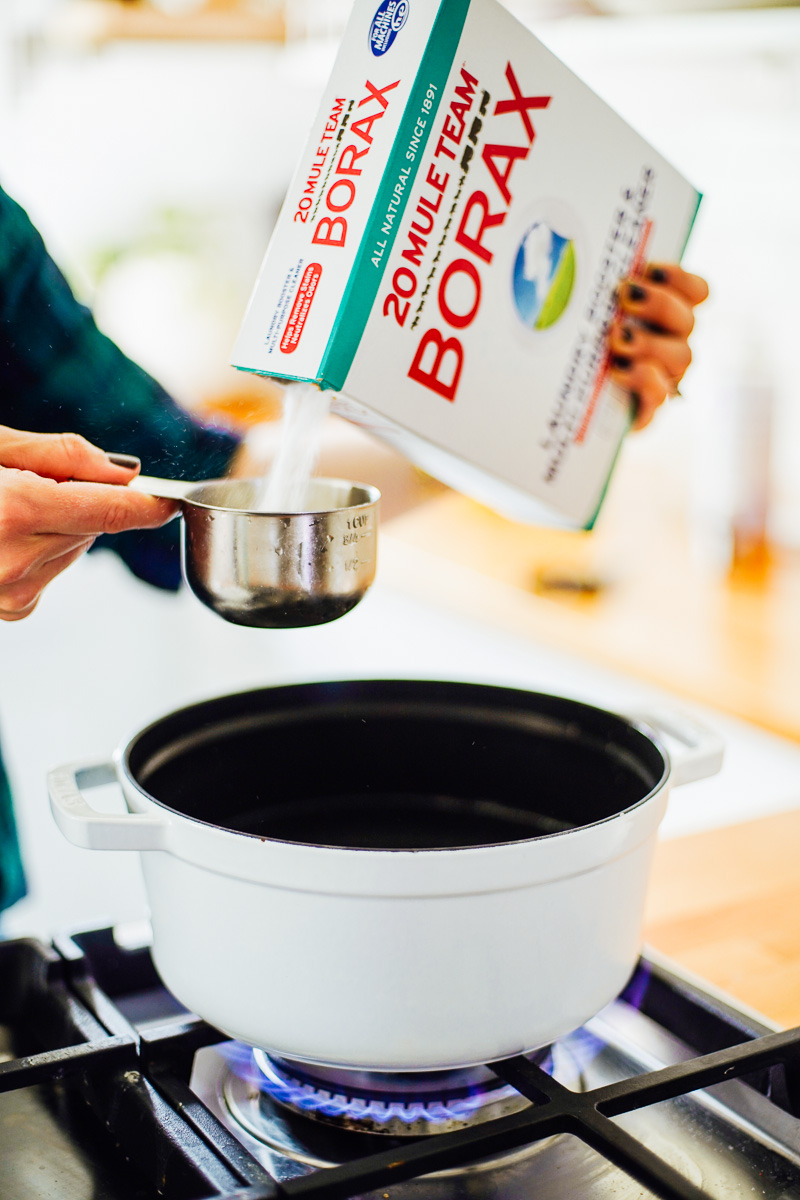
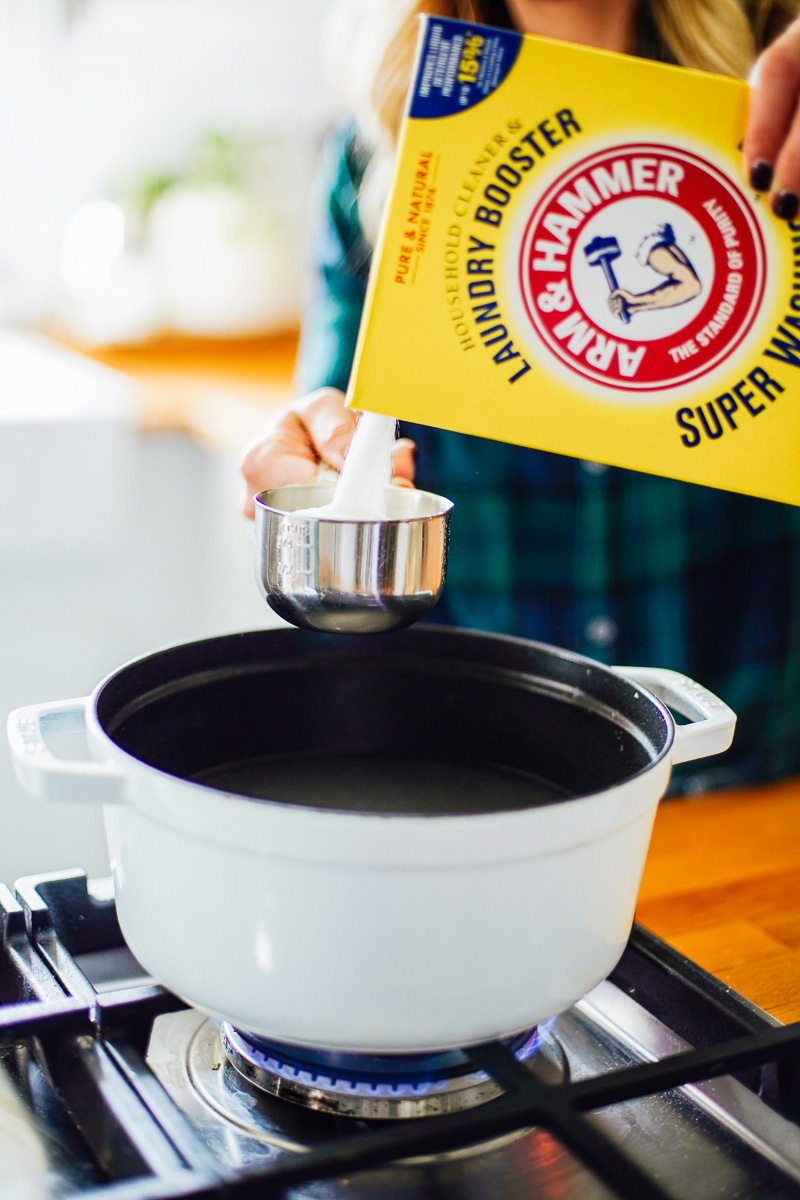
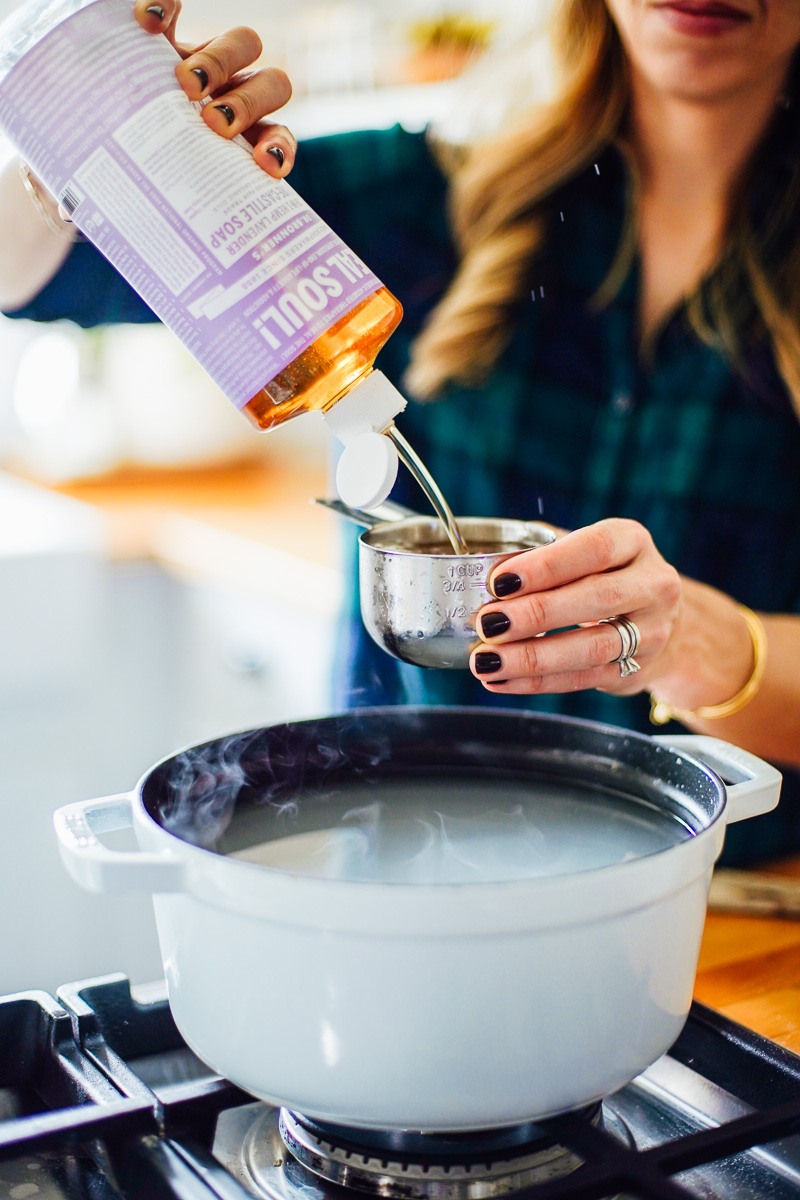
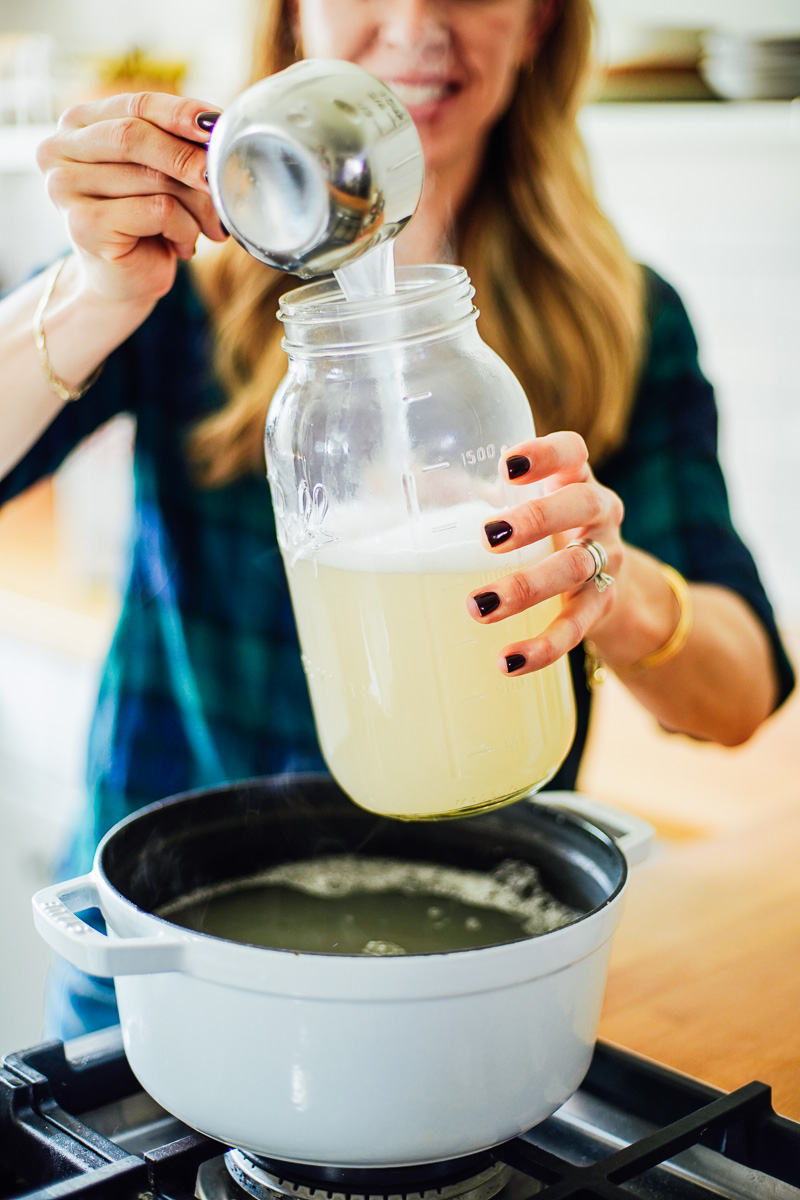
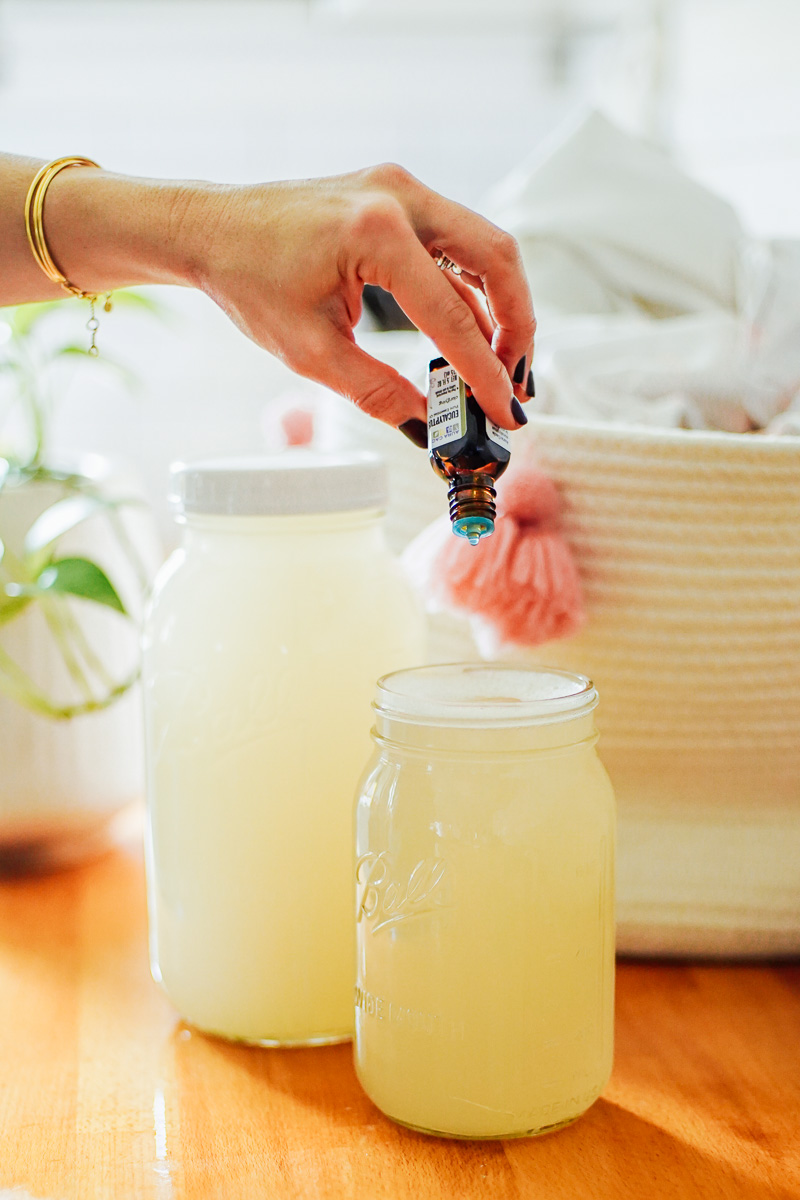
What to Avoid Doing
- Baking Soda – Don’t use baking soda in place of washing soda. Washing soda has a different chemical composition and will not work in this recipe. It is NOT a substitute.
- Dish Soap – Don’t use other dish soaps in place of the castile soap. Dish soap will cause the soap to have too many bubbles in the wash.
- Lack of Suds – Don’t assume that a lack of suds and bubbles means the soap isn’t effective. Suds and bubbles don’t equal clean.
- Plastic Containers – If you’re reusing an old detergent bottle for storage, make sure the laundry detergent is fully cool before adding to a plastic container.
- Heat-Safe Glass – Use a heat-resistant glass jar (if using glass for storage), and also allow the detergent to cool a bit (about 10 minutes) before adding it.
- Essential Oils – The essential oil will add a subtle fragrance, but shouldn’t be added until the soap cools as heat will cause the essential oil to evaporate.
How to Prevent Chunky or Gelled Detergent
After a few days the liquid laundry detergent may clump or gel. This is a completely normal chemical reaction that is usually caused when the outside temperature is cooler. There’s no way to completely prevent this from happening; however, one option is to use more water (2-3 cups more) to make a less concentrated soap.
The laundry soap is 100% usable if it gels up (l actually love this form). Simply scoop the detergent from the container and add to the washer.
Key Takeaway: Whether the laundry detergent gels up or remains liquid, it’s 100% effective and usable in both forms.
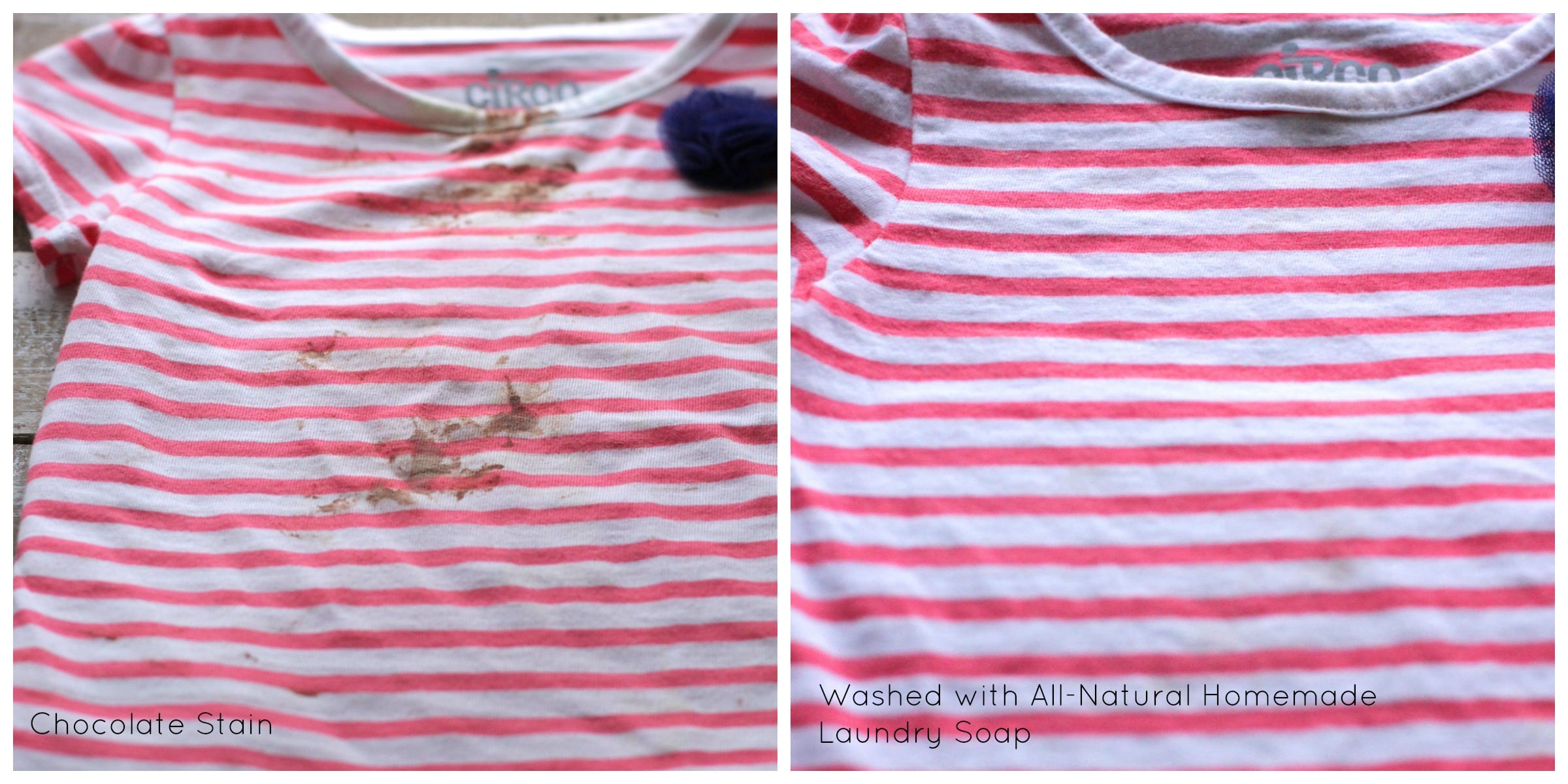
How to Use This Liquid Laundry Soap
The detergent is ready to use immediately after making. And may be stored for later use.
- Give the jar a good shake or stir (with a long spoon) before use.
- Use this detergent just as you would any laundry soap to clean clothes.
- This homemade liquid laundry soap is highly concentrated, which means you need only a tiny amount to get a dirty job done.
- For top-loading washer machines, use 1/8-1/4 cup.
- For an HE front loader, use 1-2 tablespoons.
- Add the detergent directly to your washer or the laundry soap compartment.
Can I use this in an HE washer?
I do, so I can only speak to my personal experience. I use 1-2 tablespoons per load. If it’s in gel form, add it straight to the washer on top of the clothes.
Always consult your machine’s user guide before using any laundry detergent to know what your machine can and can’t handle.
How long does this recipe last?
- Use the soap within 1 month.
- Store in your laundry room, at room temperature.
- Learn more about the safety of making your own natural cleaners.
FAQs
- Can I use a castile soap bar instead of liquid castile soap? Yes, you can. Use a cheese grater to grate a bar of castile soap into the hot water (along with the borax and washing soda). Stir and continue to boil the ingredients to dissolve fully (takes about 10 minutes). I also use a bar of castile soap to make powder laundry soap.
- Is it normal that it’s more watery than soapy? Yes, this is normal. For a thicker, more concentrated detergent, there are two options: use Sal Suds instead of castile soap OR reduce the water to 10-12 cups for a more concentrated detergent.
- The detergent is chunky (or gelled) after cooling, is that normal? Yes, this is normal. Depending on your home’s temperature, the soap may be more liquid or even chunky (like a gel). Both are normal and usable!
- My laundry soap didn’t gel. What happened? If your environment is cooler, your laundry soap may gel after cooling. Or it may not. This is normal. Both forms are 100% good and usable. A reader recently shared this tip you can try as well, “I also like the the detergent to be more gelatinous and I use my immersion blender for a few seconds after it is cool to whip it. It turns white and jelly.”
- Is borax safe? Borax is a debated ingredient in naturally-minded circles. I personally don’t see any reason to avoid it. This borax article from Wellness Mama has fantastic information.
- Can I use this soap to lift stains? Yes, you can. You can either add the garment to the washer or add the garment to your kitchen sink with the soap and water and soak the garment to lift the stains. Or, apply the soap directly to the stain and scrub. If you’re dealing with tough stain, I recommend using this homemade stain remover before washing the garment.
- Does this soap work with hard water? Yes, it does. I have hard water and this soap works great. You may want to use this laundry softener recipe as well.
Conclusion: Does this detergent work?
People always ask me, “Will homemade soap work as well as a store-bought product?” The answer, “YES! It will.”
My daughter’s chocolate stain on the left and after using this detergent in the wash. The stain lifted and the shirt was saved. If you need need extra help lifting a stain, you can also use my homemade stain remover first.
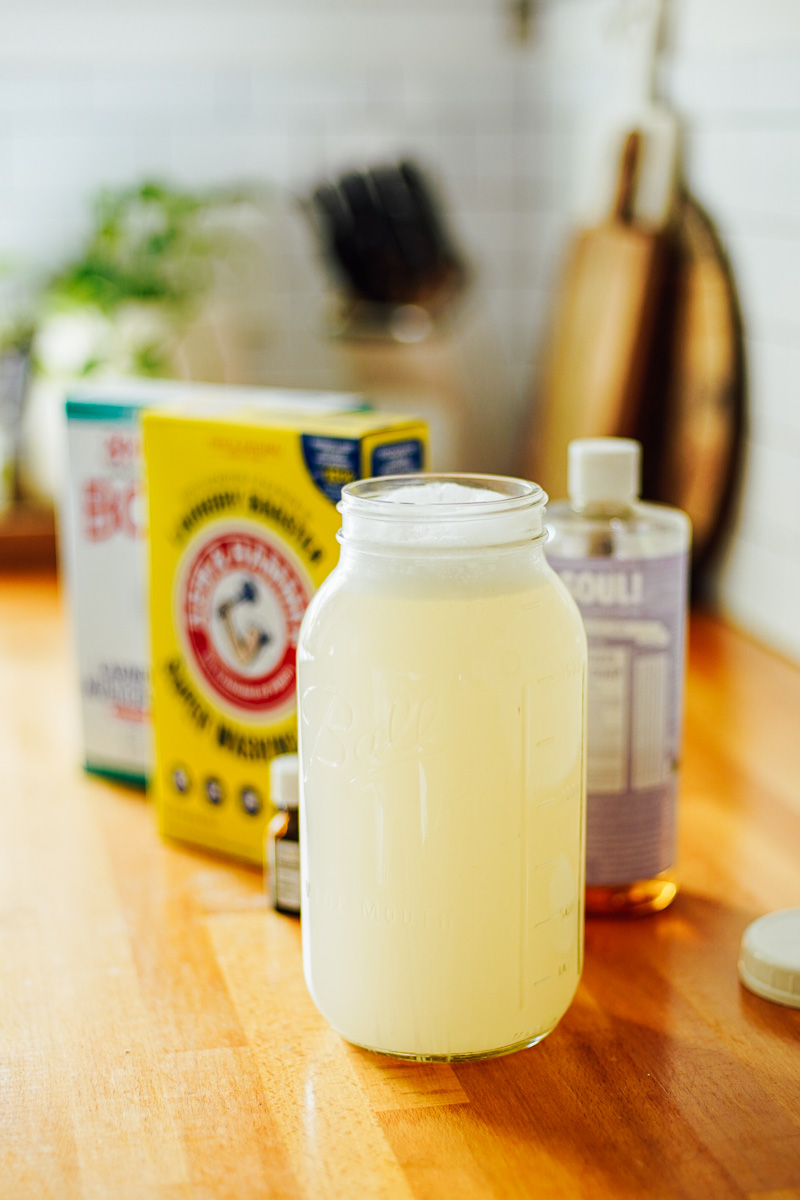

The Best Natural Laundry Detergent Brands: I’ve researched and tried many different laundry soap brands and narrowed down the best 11 brands!
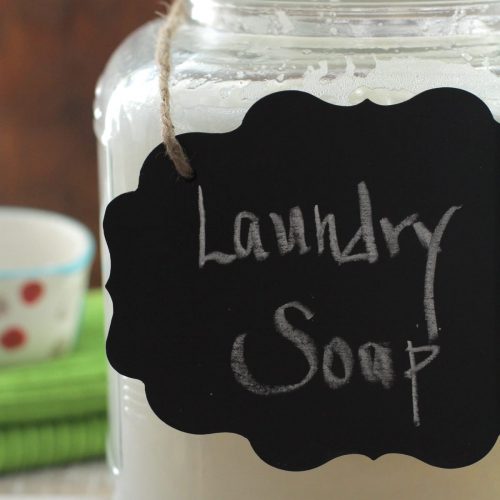
Homemade Liquid Laundry Detergent Recipe
Equipment
- 1 large saucepan or dutch oven (big enough to hold 15 cups of liquid)
- storage jars (such as 2 half gallon-size glass mason jars, 1 gallon-size jar, or reuse an old detergent bottle) for storing the laundry soap
Ingredients
- 1 cup borax
- 1 cup washing soda
- 1 cup liquid castile soap unscented or scented
- 15 cups water divided
- 50 drops essential oil optional for scent
Instructions
- In a large saucepan or Dutch oven, bring 6 cups of water to a slight boil. Once the water begins to boil, turn off the burner.
- Add the Borax and washing soda. Stir to dissolve. Then add 9 cups of room-temperature water and 1 cup of liquid castile soap. Give the ingredients a stir to combine.
- Allow the soap to cool for a few minutes before pouring into one large gallon-size jar or smaller containers, like quart-size jars. Make sure your jar(s) are heat-safe. If not, wait until the soap is cool, then spoon the soap into the jar(s).If you're reusing an old detergent bottle, make sure the soap is fully cool before adding to a plastic container.
- Add an essential oil of choice (if using) to the soap (now in the jar) and stir to combine with the detergent. The essential oil will add a subtle fragrance, but shouldn't be added until the soap cools as heat will cause the essential oil to evaporate.
- As the soap sits, the mixture may form into a gel and become chunky. There may also be liquid and gel separation, simply stir or shake. This is normal.
How to Use
- For top loading washer machines, use 1/8-1/4 cup. For a front loader, use 1-2 tablespoons. Add the detergent to the liquid soap compartment of the washer.
- Stain Treatment – Use a small amount of soap directly on the stain, scrub or rub the stain with a cloth. Repeat as needed, then wash the garment. Or use this stain remover spray.
- Laundry Softener – This laundry detergent may be used with a fabric softener. I use vinegar added to the softener compartment or this salt scent booster & softener added directly to the wash basin before running a wash cycle.

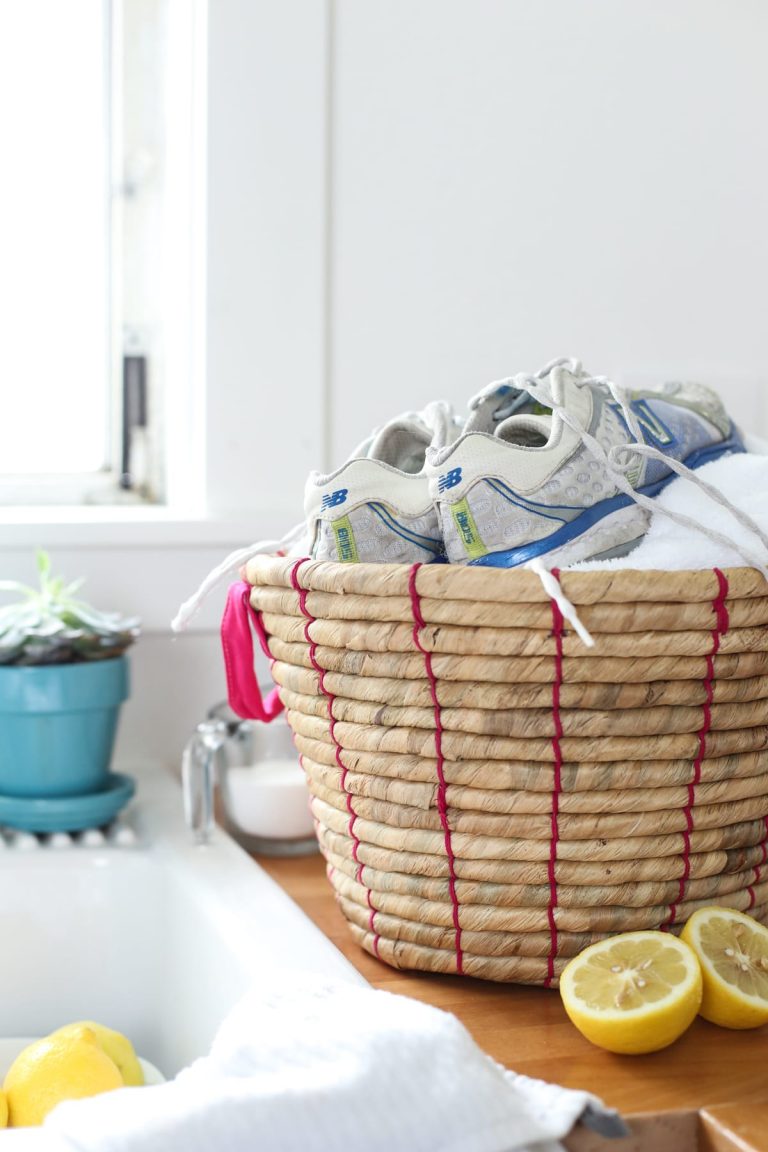
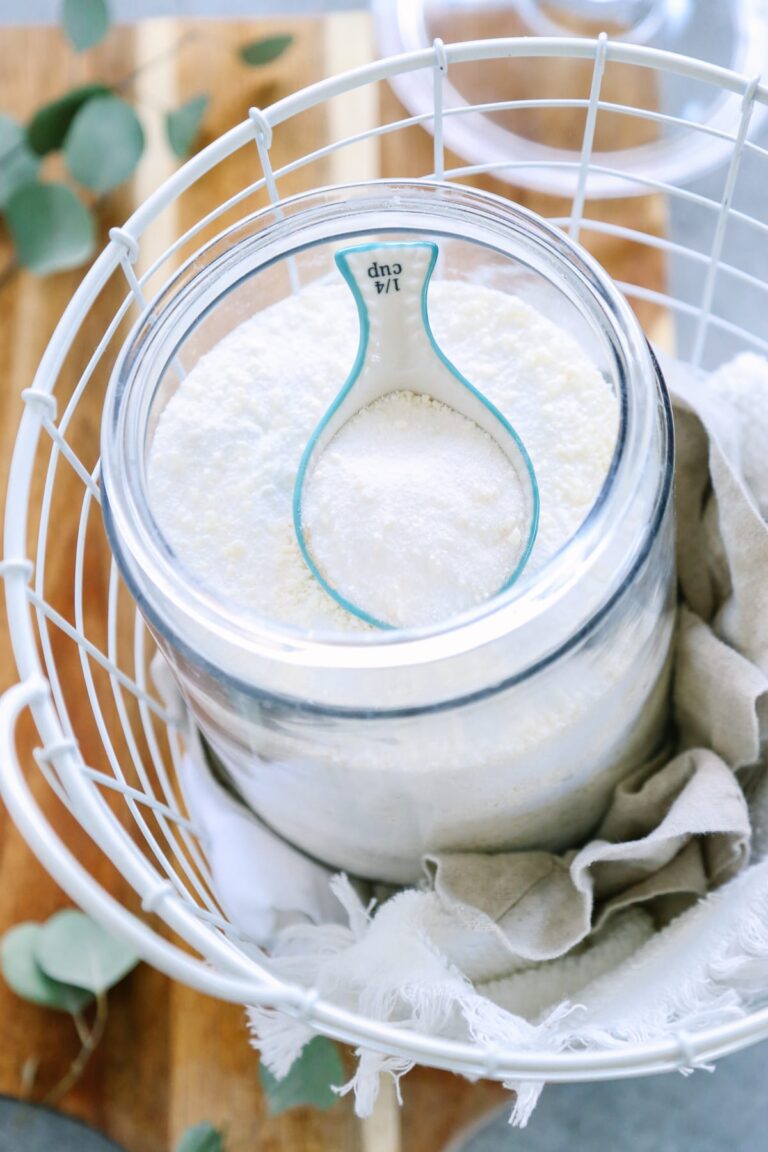
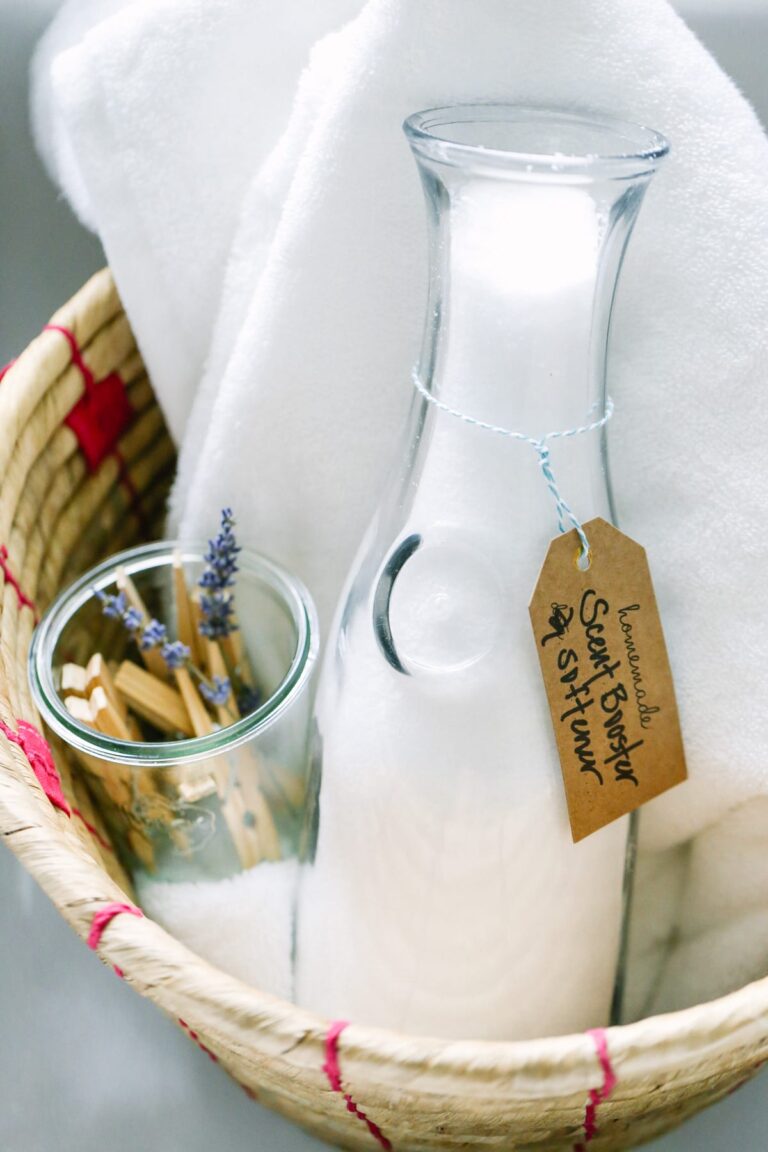

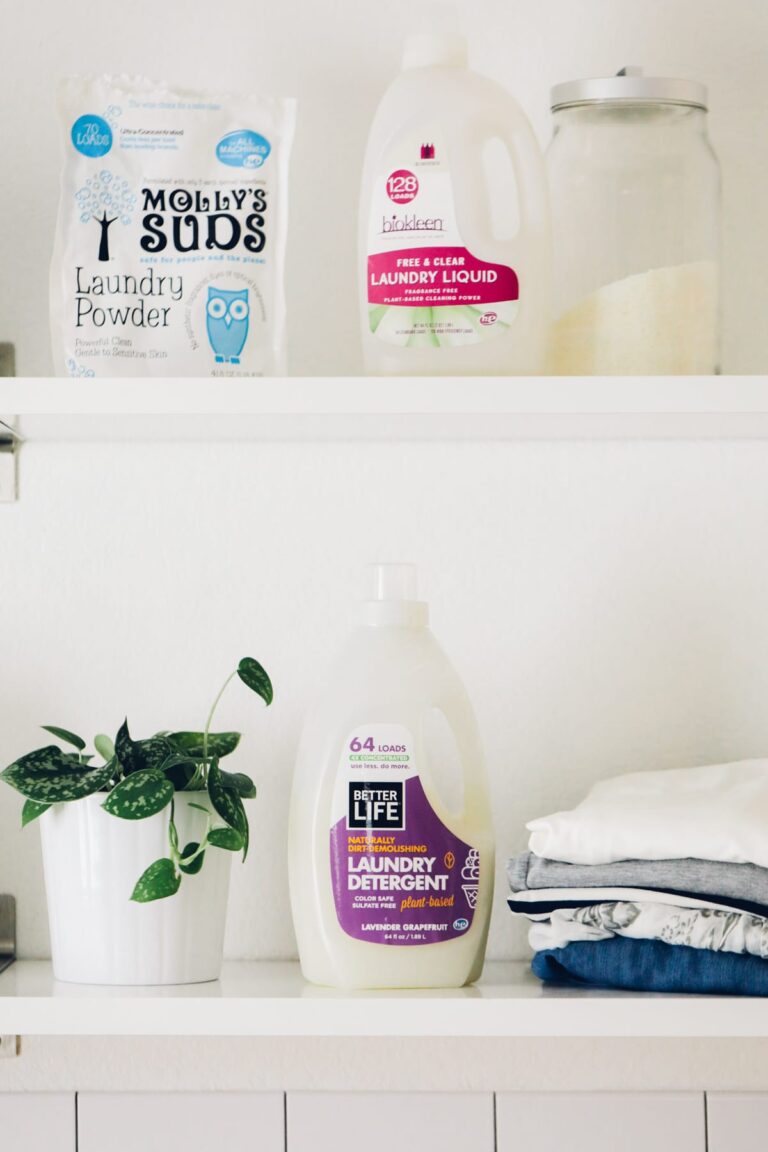
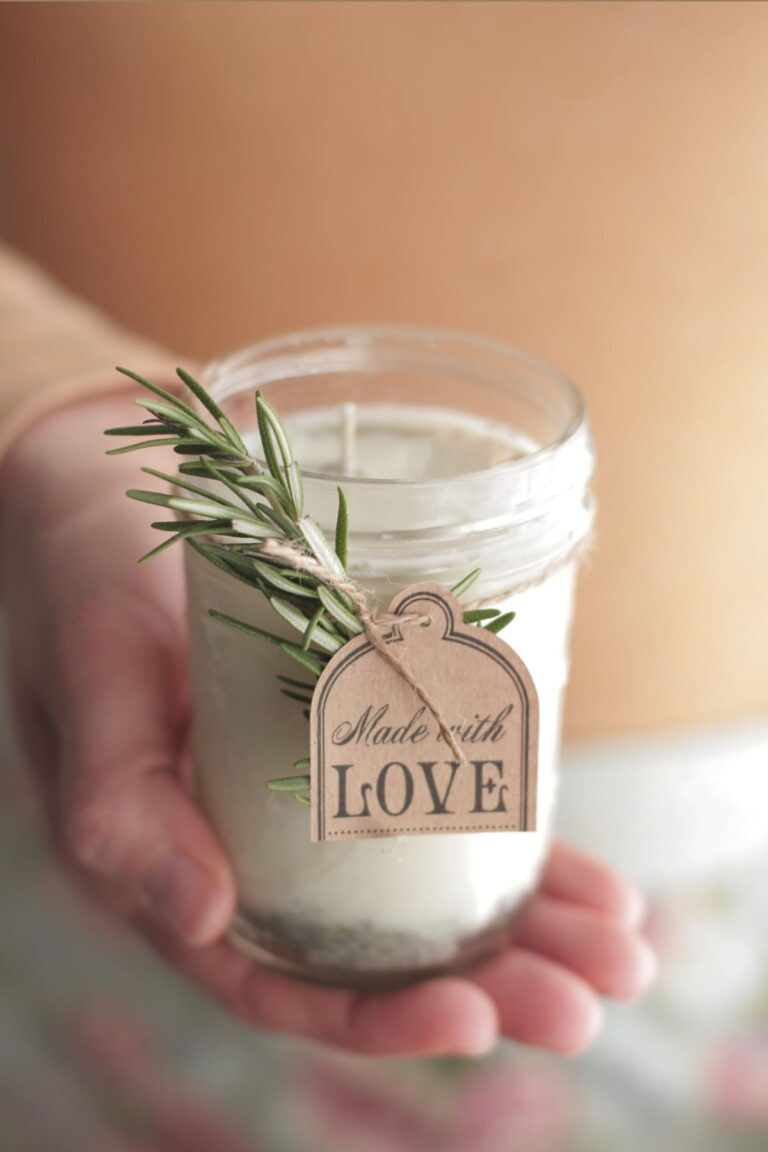
Hi Kristin, when you say “use quickly” how quickly are you referring; a couple weeks or a few months?
I’m looking forward to trying out your recipe. Right now I’m debating if I should try liquid or powder. We do have an HE washer. Would your softener work with an HE washer? You said to put the salt in when the water fills but you can’t do that with an HE- I assume I would put the salt in the softener container at the top? Thank you so much! I’m so excited that I found your blog.
Hey Lauren, Generally, a few weeks–this will depend on how it’s stored too. Here are my safety tips: https://livesimply.me/2016/09/02/my-safety-tips-for-making-and-using-natural-products/ I put the softener (or any powder) directly in my HE washer versus in the compartment.
I’m in the uk and borax isn’t available. What is the alternative please? I’d love to try this x
Hi Donna,
Kristin is currently out of the country, but I’ll make sure to let her know of your comment so she can respond when she returns. ~Rachel
Hey Donna, Possibly baking soda. Or you could make this recipe: https://livesimply.me/2018/04/20/no-borax-homemade-powder-laundry-soap-with-natural-fabric-softener/.
I was just curious what size washer you use? I have the biggest size possible since we have a larger family (#8 due in october!!). All the recipes say “you only need a small amount” but I always use more, but am always curious what size washer they use. 🙂 Thought I’d finally ask someone. 😀
Hi Bethany,
Kristin is currently out of the country, but I’ll make sure to let her know of your comment so she can respond when she returns. ~Rachel
Hey Bethany, Congrats on #8!! That’s so exciting. We have a standard size washer, I guess. I’m not sure the exact size. You could definitely increase the amount of soap. I know HE washers usually say to use less soap.
Thanks!
Hello Kristin,
It’s me again. 🙂 i just made the aloe/avocado oil facial cream and i sooo love it. I replaced almond oil with avocado coz it’s what i have at the moment, it’s so smooth and silky.
I just want to ask if there is a substitute for borax? It’s a bit difficult to find borax here in Spain. Thanks
Hi Kristin! I’ve been making your recipe for a couple of years now and I like it 🙂 I especially LOVE that I don’t have to grate bar soap 🙂 Got a question……have you ever used Sals Suds in your laundry soap instead of the regular castille soap? Wonder if it would be too harsh on the laundry, or if it would “brighten” it a bit. Not that my laundry gets dingy, because it doesn’t. It’s more the whites that I’d like to brighten up. Thanks so much for your time 🙂
Yay, Cindi. I’m so glad you’re enjoying it. You could try Sal Suds, but you’ll want to reduce the amount used since it is a detergent and extra bubbly. I’m not sure how much. You could also try something like this whitener (I add it directly to the washer): https://amzn.to/2HupCjX.
Thank you Kristin! i added the whitener to my shopping list. Sounds like just what I’m looking for. I’ve been staying away from bleach and using hydrogen peroxide, which has worked quite well, but this looks less complicated 🙂
Hi,
does it effect the washing machine (in terms of mechanical problems) in the long run ?
And do you have suggestions to protect machine (while using such DIY products ?
Thank you
Selen
Hey Selen, I haven’t found it to have any impact on my washer. I run vinegar in my washer once a month to clean it out.
Hello, I tried your recipe here but I halved everything because I am a bachelor with just my daughter and I. It seems to work well and clothes are clean but there is no suds at all, it really just looks like plain water washing in my HE tub. Is this normal? I have been using an old tide bottle cap to measure with and fill it up to the 1or 2 line for normal to heavy loads.
Thanks for any advise
Joe
Hey Joe, Yes, this is normal. Most commercial detergents add foaming agents.
I found your website as it had some DIY laundry recipes, as that is what I have decided I want and was forced to do. I was curious to see what ingredients you used. The internet is full of DIY recipes for everything-thank goodness. I truly am not trying to be critical in my comment here. My intent is to only create an awareness. My life has evolved to the point (this is and can be a process), where I am on a quest to find NON-TOXIC recipes and rid of my home of ALL chemicals. Did you know that the average household contains about 68 of them-yikes. We are all breathing this is into our lungs everyday, yes….even as they just sit in the bottles. While I find some blogs to be very helpful in their intent, I am specifically looking for ones that don’t hurt the environment or me and my family. Once we take a look at the ingredients and their impact (toxicity) on our lives, it just begs the question, why would we, as moms, knowingly put carcinogens on our bodies or our kids/familiy or prepare/buy food that will cause us/our families to develop sickness? This is a whole nother subject. Yes the companies producing these products know the chemicals they use are toxic. I would think this alone would give us reason for pause. Education is so necessary in pursuing a healthy lifestyle. I always use EWG as a guide when considering buying or making my own products. Until I became chemical sensitive (don’t think it can’t happen to you-I never did), I too went about my day unaware of the toxins in everything I was buying/eating. About 3 years ago I developed chemical sensitivities and all kinds of allergies. I then was literally forced to take the valuable time to research ingredients, to learn how the body reacts to our environment and then realized what I had unknowingly been doing to my body my entire life-poisoning it ( I am 67). My body had reached the point where it was screaming ENOUGH! I now not only want an economical product, but a non toxic one. I find this critical. Knowledge is power ladies. We are literally killing ourselves/our families by creating diseases in our bodies with all the chemicals we are exposed to from food, to personal care products (our skin is the largest organ on our body), to cleaning products….the list goes on and on. Think of our little ones whose bodies are much more susceptible to all the toxins we are knowingly and unknowingly exposing our precious ones to? I would hope that would awaken our interest in creating the healthiest environment we can, so they are less likely to develop sickness/disease like we have. Hopefully, we become not just interested in the economics of making/buying our own products, but we become interested in our kids, grand kids and future generations to come by knowing what ingredients, foods etc to avoid. Our lives depend on it as the bottom line is always profit for companies. As the CEO of OUR families, we have the power to start the process of change in our own homes. Who knows where that will lead? The possibilities are endless ladies :>)
Thank you for sharing your journey, Janice! Thankfully, these days, we can educate ourselves, and then have the option to support great companies making clean products or make our own products (if desired). It’s so empowering to know that we have a choice in what we use.
I made your laundry soap about a months ago (1/2 batch)……I love it, thank you so much.
To help dissolve the Soda & Borax I used my hand held blender, worked like a charm. My batch did thicken when it cooled off, not sure why, but that made me feel a bit more confident in it LOL.
Today I’m making a full batch. My son does his laundry at my place so I’m making some for him to try, he’s more of a sceptic than I, but said he’ll use it as long as it works. I’m sure I can convert him.
Thank you for sharing this, I really appreciate it. Funny thing, I feel a bit of pride when I do laundry knowing I made the soap 🙂
When I made a tiny batch ahead of time to test and use immediately, it formed major clumps all over, (Hardened clumps) immediately as soon as I added the liquid castile soap. I figured my ratio of water and warmth/coolness of the water was off, since I didn’t make the full batch. So my question is, ***Is the “thickened” liquid still usually supposed to stay smooth? Is clumpy what we’re trying to avoid? Or is clumpy fine to use?*** I wasn’t sure. 🙂 Thank you so much!
Hey Liz, It can get clumpy, and if it does it’s still good to use :).
Love it, Nikki! I’m so glad that worked for you.
Thanks Kristin! And I noticed you said you typically just go ahead and wash in warm water for stains; if the baby or kid clothes say wash in cold water do you typically just disregard those instructions and still use warm water in order to rid the stains or just in general don’t bother with cold water?
If clothing has special washing instructions, I definitely wash it separately. Most of our clothes, these days, don’t require special instructions so the warm water works well.
Hi Kristin,
Me again~ I remembered your picture you posted of the stain. Do you do anything for stain treating?
Hey Liz, I will for grease or blood. But I usually don’t for most garments.
Hi Kristin!
Thank you so much for this post.
Recently, I bought Ecos detergent that was absolutely deceivingly “natural” and I ended up with a rash from my scalp to my ankles… Jeeze.
I just made a batch of this and I can’t wait to be rash free and truly natural again! 😀
Awesome, Abigail! I’m so glad the recipe is helpful for you.
Thanks again, Kristin!
Hello, Kristin! Thanks for this awesome recipe! I just made my first batch and while it worked very well, I have to shake it really, really vigorously every single time. Is this normal? If it is, what could I use to shake it with less strain, maybe a kitchen tool?
Hey Vicky, You don’t need to shake it vigorously each time. You could stir it with a wood spoon, too.
Thanks for this recipe for natural laundry detergent! I have recently wanted to try to make my own but wasn’t sure about the measurements so this recipe was perfect!
I do have a question…have you tries this recipe with Dr. Bronner’s Sal Suds instead of Dr. Bronner’s Castile Soap? I LOVE the cleaning power of Sal Suds however, it is a detergent and I was just wondering if Sal Suds would result in a different texture or if Sal Suds would make this recipe too harsh. Thanks So Much!
Hey BrownLuster, You’d probably just need to reduce the amount of Sal Suds used? Or just use a small amount of the soap in the washer. Sal Suds does have more suds than castile soap.
Thanks for your quick reply Kristin!
So what I will do is use less laundry soap as a try initially. I am a Sal Suds fan + I am concerned about soap buildup in the washer and on my clothes and linens. However, as you also stated, Sal Suds will definitely create lots of suds which is not good for the HE machines. I will make adjustments of the ratio of wash soap to Sal Suds as well as search for a natural solution to add to the purified water to help cut back on the sudsing power of the Sal Suds. I’m thinking maybe Aloe Vera Juice?!? Idk…it’s a discovery phase taht I’m excited to embark on now that I have a base recipe ans measurements, so Thank You!
I am also quite excited to try the DIY fabric softener (cheap hair condish/white vinegar/purified water) mentioned on this thread by posters!! I have a bottle of unused Vo5 condish that would be perfect for this too! Lol.
I am so glad I found your blog/site as well as the wonderful natural solutions that posters have suggested. Thanks so much everyone!
Hi Kristin,
Would you be able to sub out the borax with more of the washing soda? (I know borax is not necessarily a bad thing in general, but just wondering in prep of a newborn, whether this is an option just to stay on the safest side possible to avoid any skin irritation of very sensitive newborn skin.) Or is it a needed ingredient in this mix?
Hey Liz, I would try baking soda as the sub for borax. Congrats!
On your laundry soaps you say they are best in hot water. I wash my colored clothes in cold water, so does it work well with cold water. Or do you have one for cold water. Also, I like a whitening booster for my color laundry do you have a natural one. I use oxi clean sometimes.
I clean houses part time and I wanted to know if you have a great household cleaner that cleans soap scum really well. I have made several but they just do not clean that well. Thanks for your help.
Hey Brenda, You can definitely try cold. I’ve personally found that many soaps, particularly a powder soap like my other recipe, work best in warmer water. We also have very hard water, so I’m always looking for ways to boost the cleaning power of my products. For soap scum, I would try a solution of 50/50 vinegar and water, or you could mix together baking soda with a bit of water to form a paste and scrub the area.
Interested to know what the purpose of glyerin is?
Hey Deborah, It adds moisturizing properties.
Your laundry soap recipe sounds really simple. I love easy it is to make environmentally clean cleaning products like you have here.
Borax is somewhat questionable safety, so I wonder if you’ve tried laundry without it? What are your thoughts about the results?
What if, skipping the borax, we go really simple at laundry time and just put a bit of castile soap and washing soda in the washing machine?
You could try that, Elizabeth. I’ve tried skipping Borax (I personally don’t have an issue with it), and find that the clothes just don’t get as clean as I’d like. Definitely try experimenting and let me know how it goes!
I am going to try this recipe when I finish using the liquid laundry soap now and was wondering if I make this a smaller recipe ( I am the only one at my house) should I just cut everything in half. Also when you use more than one essential oil how do you know how much to add of each one. I am thoroughly enjoying you recipes. Very happy I found them. Have you made a dishwasher soap recipe yet?